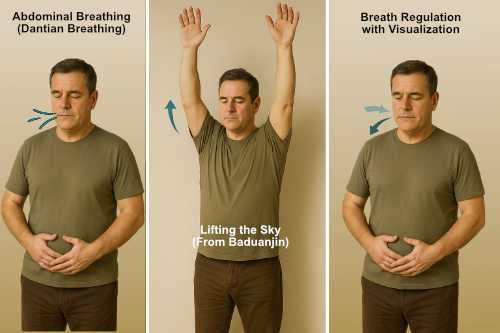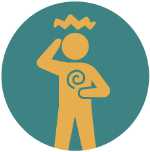Qigong Breathing Exercises for Asthma
For people with asthma, breathing can sometimes feel like a struggle rather than the natural, effortless rhythm it should be. While inhalers and medications play a crucial role in managing asthma symptoms, Traditional Chinese Medicine (TCM) also recognizes the value of self-care techniques that strengthen the lungs and restore balance. Among these, qigong breathing exercises are especially helpful—and accessible.
Qigong (气功) is a system of meditative movement and breath training used for health, longevity, and internal balance. In TCM, the Lung (Fèi 肺) is responsible for governing Qi and respiration. When Lung Qi is weak or obstructed—by cold, heat, phlegm, or emotional tension—breathing becomes shallow or labored. Qigong offers a gentle way to clear stagnation, improve lung function, and cultivate internal strength.
Unlike cardio-based exercise, qigong breathing emphasizes slow, deliberate breaths coordinated with relaxed movement and mental focus. For people with asthma, this retrains the respiratory system to function more efficiently without strain.
Basic Qigong Techniques for Asthma
1. Abdominal Breathing (Dantian breathing)
Many people breathe with their chest, especially when anxious or short of breath. Qigong teaches dantian (丹田) breathing—drawing the breath deeply into the lower abdomen. This technique strengthens the diaphragm and reduces tension in the upper chest. Inhale slowly through the nose, letting the abdomen expand. Exhale gently through the mouth, allowing the belly to fall. Practicing this for 5–10 minutes a day can help reduce the frequency and severity of asthma attacks.
 2. "Lifting the Sky" (from Baduanjin 八段锦)
2. "Lifting the Sky" (from Baduanjin 八段锦)
This simple movement involves raising the arms overhead while inhaling, then lowering them while exhaling. It opens the chest and regulates the breath in rhythm with motion. Performed gently, it can help relieve tightness in the chest and promote smoother breathing. Even five repetitions can calm the nervous system and support the Lungs.
3. Breath Regulation with Visualization
Qigong often includes imagery. One common practice involves visualizing clean, healing air entering the lungs with each breath, and dark, stagnant Qi leaving the body on the exhale. This mental focus supports relaxation and reinforces the healing intention.
Why It Works
TCM recognizes that the body responds to intention, rhythm, and internal awareness. Asthma frequently flares in response to stress or environmental triggers. Qigong helps by shifting the nervous system toward a more parasympathetic, restful state. It also gently improves the Lung’s ability to “disperse and descend Qi”—the process of inhaling clean air and exhaling waste.
Because qigong is low-impact and adaptable, it’s suitable for all ages and levels of mobility. For those managing chronic asthma, it can become a quiet, daily ritual that builds resilience over time.
As always, qigong is not a replacement for prescribed medications or emergency care. But as a regular practice, it offers a way to reconnect with the breath—not just to manage symptoms, but to live more fully with every inhale and exhale.
Vocabulary Guide
- Qigong (气功) – Breath and energy cultivation exercises
- Fèi (肺) – Lung; governs qi and respiration
- Qi (气) – Vital energy or life force
- Dan tian (丹田) – Energy center in the lower abdomen
- Baduanjin (八段锦) – “Eight Brocades,” a popular qigong sequence





